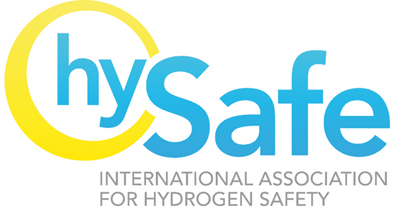| Title |
Contact Author |
Country |
| The Effect of Iron on the Solubility Behavior of Hydrogen in Tantalum |
Manju Taxak |
India |
| Advancing the Hydrogen Safety Knowledge Base |
Steven Weiner |
United States |
| THE SLOW BURST TEST AS A METHOD FOR PROBABILISTIC QUANTIFICATION OF CYLINDER DEGRADATION |
Georg Mair |
Germany |
| Ignition of Hydrogen Jet Fires from High Pressure Storage |
Armin Kessler |
Germany |
| Radiation from Hydrogen Jet Fires Investigated by Time-Resolved Spectroscopy |
Achim Schreiber |
Germany |
| What is an Explosion? |
Jay Keller |
United States |
| JRC Reference Data from Experiments of Onboard Hydrogen Tanks Fast Filling |
Beatriz Acosta |
Netherlands |
| Hydrogen Systems Component Safety |
Carl Rivkin |
United States |
| Updated Jet Flame Radiation Modeling with Corrections for Buoyancy and Wind |
Isaac Ekoto |
United States |
| CFD modeling and consequence analysis of an accidental hydrogen release in a large scale facility. |
C. Regis Bauwens |
United States |
| EXPERIMENTAL STUDY OF VENTED HYDROGEN DEFLAGRATION WITH IGNITION INSIDE AND OUTSIDE THE VENTED VOLUME |
Martino Schiavetti |
Italy |
| CFD simulations of the effect of ventilation on hydrogen release behavior and combustion in an underground mining environment |
Pierre Benard |
Canada |
| Deploying Fuel Cell Systems: What Have We Learned? |
Nick Barilo |
United States |
| Simulation of Hydrogen Dispersion under Cryogenic Release Conditions |
Stella, G. Giannissi |
Greece |
| EVALUATION OF THE ADREA-HF CFD CODE AGAINST A HYDROGEN DEFLAGRATION IN A TUNNEL |
ILIAS C. TOLIAS |
Greece |
| Development of standards for evaluating materials compatibility with high-pressure gaseous hydrogen |
Chris San Marchi |
United States |
| Hydrogen compatibility of austenitic stainless steel tubing and orbital tube welds |
Chris San Marchi |
United States |
| Safety modeling of hydrogen: from the release of LH2 or GH2 to the use of recombiners as passive safety devices |
Christian Jäkel |
Germany |
| Feasibility of hydrogen detection by the use of uncoated silicon microcantilever-based sensors |
Isabelle Dufour |
France |
| Trends in gas sensor development for hydrogen safety |
Thomas Hübert |
Germany |
| time response of hydrogen sensors |
Thomas Hübert |
Germany |
| CFD based simulation of hydrogen release through elliptical orifices |
Nasim Shishehgaran |
Canada |
| Indoor use of hydrogen, knowledge gaps and priorities for the improvement of current standards on hydrogen, a presentation of HyIndoor European project |
Sidonie Ruban |
France |
| Safety Issues of the Liquefaction, storage and transportation of liquid hydrogen |
Barbara Lowesmith |
United Kingdom |
| HYDROGEN STORAGE - RECENT IMPROVEMENTS AND INDUSTRIAL PROSPECTIVES |
HERVE BARTHELEMY |
France |
| Combustion modeling in large scale volumes |
Alexey Velikorodny |
France |
| Evaluation of Selectivity and Resistance to Poisons of Commercial Hydrogen Sensors |
Valerio Palmisano |
Netherlands |
| Vented hydrogen-air deflagration in a small enclosed volume |
Xavier Rocourt |
France |
| An Assessment on the Quantification of Hydrogen Releases Through Oxygen Displacement Using Oxygen Sensors |
Lois Boon-Brett |
Netherlands |
| Experimental investigation of nozzle aspect ratio effects on underexpanded hydrogen jet release characteristics |
Adam Ruggles |
United States |
| Safety concept of a self-sustaining PEM Hydrogen Electrolyzer System |
Gaelle Hotellier |
Germany |
| Status, gaps and recommendations regarding standardisation and the use of hydrogen in sustainable buildings |
Gerd Petra Haugom |
Norway |
| CFD BENCHMARK BASED ON EXPERIMENTS OF HELIUM DISPERSION IN A 1 M3 ENCLOSURE– INTERCOMPARISONS FOR PLUMES AND BUOYANT JETS. |
gilles bernard-michel |
France |
| Modelling and effect of Rayleigh-Taylor instability on coherent deflagrations |
James Keenan |
United Kingdom |
| Ignited Releases of Liquid Hydrogen: Safety considerations of thermal and overpressure effects. |
Jonathan Hall |
United Kingdom |
| Influence of doping element in distributed hydrogen optical fiber sensors with Brillouin scattering |
Johan BERTRAND |
France |
| Modelling and simulation of lean hydrogen-air deflagrations |
Dmitriy Makarov |
United Kingdom |
| Discussion of lessons learned from a hydrogen release |
Aaron Harris |
United States |
| PASSIVE VENTILATION OF A SUSTAINED GASEOUS RELEASE IN AN ENCLOSURE WITH ONE VENT |
Volodymyr Shentsov |
United Kingdom |
| HYDROGEN NON-PREMIXED COMBUSTION IN ENCLOSURE WITH ONE VENT AND SUSTAINED RELEASE: NUMERICAL EXPERIMENTS |
Volodymyr Shentsov |
United Kingdom |
| A Study on the Continuous Spill with Limited Period of Release |
Myungbae Kim |
Korea, Republic Of |
| Evolution in Hydrogen Safety Activities, Regulations, and Standards in China Over the Last Decade |
Zhengli Hua |
China |
| Safe storage of compressed hydrogen at ambient and cryogenic temperatures in flexible glass capillaries |
Nickolay Zhevago |
Russian Federation |
| Effectiveness of a blower in reducing the hazard of hydrogen leaking from a hydrogen-fueled vehicle |
Yohsuke Tamura |
Japan |
| INFLUENCE OF THE LOCATION OF A BUOYANT GAS RELEASE IN SEVERAL CONFIGURATIONS VARYING THE HEIGHT OF THE RELEASE AND THE GEOMETRY OF THE ENCLOSURE |
Deborah HOUSSIN-AGBOMSON |
France |
| Numerical study on detailed mechanism of H2 / Air Flame Jet Ignition |
Hajime BITOH |
Japan |
| Hydrogen-air vented explosions: new experimental data |
Jerome Daubech |
France |
| Development of a Hydrogen and Fuel Cell Vehicle Emergency Response National Template |
Jennifer Hamilton |
United States |
| Strong and Mild Ignition Mechanism behind Reflected Shock Waves in Hydrogen Mixture |
Makoto Asahara |
Japan |
| Hydrogen distribution in enclosures: on distinction criterion between quasi-homogeneous mixing and stratification modes |
Igor Kirillov |
Russian Federation |
| Catalysis of Oxides in Hydrogen Generation by the Reaction of Al with Water |
Zhen-Yan Deng |
China |
| Comparison of Solutions for a Liquid Pool Spreading Model with Continuous and Instantaneous Spills |
Byung-il Choi |
Korea, Republic Of |
| An inter-comparison exercise on engineering models capabilities to simulate hydrogen vented explosions |
Simon Jallais |
France |
| APLICATION OF NATURAL VENTILATION ENGINNERING MODELS TO HYDROGEN BUILD UP IN CONFINED ZONES |
Simon Jallais |
France |
| SYNGAS EXPLOSION REACTIVITY IN STEAM METHANE REFORMING PROCESS |
Simon Jallais |
France |
| THE STUDY ON THE INTERNAL TEMPERATURE CHANGE OF TYPE3 AND TYPE4 COMPOSITE CYLINDER DURING FILLING |
CHANGJONG KIM |
Korea, Republic Of |
| STUDY ON BEHAVIOR OF AMBIENT HYDRAULIC CYCLING TEST FOR 70 MPA TYPE-3 HYDROGEN COMPOSITE CYLINDER |
Sungmin Cho |
Korea, Republic Of |
| Comparison of Numerical and Algebraic Models of Low and High Pressure Hydrogen Jet Flows with Ideal and Real Gas Models |
David Christopher |
China |
| RISK ANALYSIS ON MOBILE HYDROGEN REFUELING STATIONS IN THE WORLD EXPO SHANGHAI |
Jianxin MA |
China |
| Real size calculation of high pressure hydrogen flow and its auto-ignition in cylindrical tube |
A. Koichi Hayashi |
Japan |
| Failure of PEM water electrolysis cells: case study involving anode dissolution and membrane thinning |
Sergey Grigoriev |
Russian Federation |
| Application of Risk Assessment Approach on a Hydrogen Station |
Arshad Ahmad |
Malaysia |
| COST EFFECTIVE INHERENT SAFETY INDEX FOR POLYMER ELECTROLYTE MEMBRANE FUEL CELL SYSTEMS |
Mohamad Wijayanuddin Ali |
Malaysia |
| Experimental and numerical study on spontaneous ignition of hydrogen-methane jets in air |
Wojciech Rudy |
Poland |
| Very low-cost visual and wireless sensors for effective hydrogen gas leak detection |
William Hoagland |
United States |
| Implementation of Large Scale Shadowgraphy in Hydrogen Safety Phenomena |
Kadeem Dennis |
Canada |
| Large eddy simulation of radiative characteristics of under-expanded hydrogen jet fire |
Jennifer Wen |
United Kingdom |
| The Effect of Tube Internal Geometry on the Propensity to Spontaneous in Pressurized Hydrogen Release |
Jennifer Wen |
United Kingdom |
| Effects of chemical kinetics on ignition of hydrogen jets |
Luc Bauwens |
Canada |
| HELIOS: A new method for Hydrogen permeation test |
Renzo Valentini |
Italy |
| Safety and Risk Management in Hydrogen Production with Thermochemical Water Splitting Cycles |
Edward Secnik |
Canada |
| Numerical simulations of spontaneous ignition of high-pressure hydrogen based on detailed chemical kinetics |
Hiroshi Terashima |
Japan |
| Introductory course on hydrogen safety at CENEH - UNICAMP |
Newton Pimenta |
Brazil |
| Accumulation of hydrogen released into a vented enclosure - experimental results |
Phillip Hooker |
United Kingdom |
| Material Testing and Design Recommendations for Components exposed to HYdrogen enhanCed fatigue – the Mathryce project |
Laurent Briottet |
France |
| Large Scale Passive Ventilation Trials of Hydrogen |
stuart hawksworth |
United Kingdom |
| Vented hydrogen-air deflagrations in low strength equipement and buildings |
Vladimir Molkov |
United Kingdom |
| A Turbulent Combustion Model for Ignition of Rapidly Expanding Hydrogen Jets |
Brian Maxwell |
Canada |
| Uncertainties in risk assessment of Hydrogen discharges from pressurized storage vessels ranging from cryogenic to ambient temperatures |
Frank Markert |
Denmark |
| ASSESSMENT OF A CFD MODEL FOR SIMULATIONS OF FAST FILLING OF HYDROGEN TANKS WITH PRE-COOLING |
Daniele Baraldi |
Netherlands |
| EXPERIMENTAL INVESTIGATION OF FLAME AND PRESSURE DYNAMICS AFTER SPONTANEUS IGNITION IN TUBE GEOMETRY |
Joachim Grune |
Germany |
| EXPERIMENTAL STUDY OF THE THERMAL BEHAVIOUR OF HYDROGEN TANKS DURING HYDROGEN CYCLING |
Nerea de Miguel |
Netherlands |
| Dependence of hydrogen embrittlement on hydrogen in the surface layer in type 304 stainless steel |
Jinyang ZHENG |
China |
| STRUCTURAL HEALTH MONITORING TECNIQUES FOR DAMAGES DETECTION IN HYDROGEN PRESSURE VESSELS |
Iñaki Azkarate |
Spain |
| The mitigation of hydrogen explosions using water fog, nitrogen dilution and chemical additives |
Paul Holborn |
United Kingdom |
| Hydrogen Safety Research Priorities |
Alexei Kotchourko |
Germany |
| EFFECT OF TEMPERATURE ON LAMINAR FLAME VELOCITY FOR HYDROGEN-AIR MIXTURES AT REDUCED PRESSURES |
Mike Kuznetsov |
Germany |
| Computational analysis of Hydrogen Diffusion in Polycrystalline Nickel and Anisotropic Polygonal Micro, Nano Grain Size Effects |
Sathiskumar Jothi |
United Kingdom |
| EUROPEAN HYDROGEN SAFETY TRAINING PLATFORM FOR FIRST RESPONDERS: HYRESPONSE PROJECT |
Franck Verbecke |
France |
| Ignition of flammable hydrogen/air mixtures by controlled glancing impacts in nuclear waste decommissioning |
Anthony Averill |
United Kingdom |
| A comparative study of detonability and propensity to sustain high-speed turbulent deflagrations in hydrogen and methane mixtures |
Logan Maley |
Canada |
| Numerical simulation of the helium dispersion in a semi-confined air-filled cavity |
Huong-Lan TRAN |
France |
| Effect of initial turbulence on vented explosion overpressures from lean hydrogen-air deflagrations |
C. Regis Bauwens |
United States |
| Evaluation of Hydrogen, Propane and Methane-Air Detonations Instability and Detonability |
Bijan Borzou |
Canada |
| Experimental investigation of nonideality and nonadiabatic effects under high pressure releases |
Mike Kuznetsov |
Germany |
| H2FC EUROPEAN INFRASTRUCTURE; Research opportunities to focus on scientific and technical bottlenecks |
Olaf Jedicke |
Germany |
| CO2-Free Hydrogen Supply Chain Project and Risk Assessment for the Safety Design |
Suguru Oyama |
Japan |
| Safety design of compressed hydrogen trailers with composite cylinders |
Makoto Azuma |
Japan |
| HYDROGEN BUBBLE DISPERSION AND SURFACE BURSTING BEHAVIOUR |
James Ingram |
United Kingdom |



